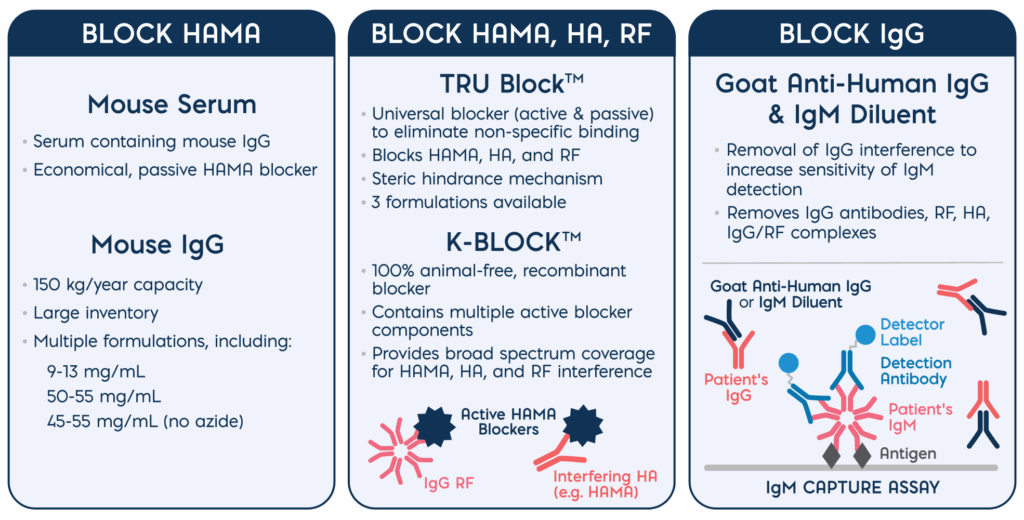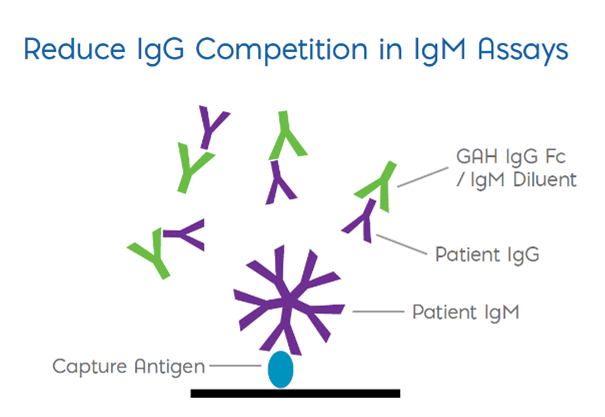Choose a country to view content specific to your location
Immunoassay blockers are used in diagnostic assays to reduce non-specific binding and other interference that can lead to false-positive results. Specifically, antibody interference from human anti-mouse antibodies (HAMA), rheumatoid factor (RH), and heterophilic antibodies (HA) are a major concern in both paired monoclonal sandwich assays and competitive assays. In IgM detection assays, IgG antibodies which are present in 10-15x higher concentrations than IgM can also reduce assay sensitivity due to their sheer abundance. Specialized blockers are required to reduce antibody interference from HAMA, HA, RF and IgG to ensure an assay’s accuracy and improve its sensitivity. immunoassat blockers

Contact us to learn more about Meridian’s molecular or immunoassay reagent portfolio. We want to hear from you!

Discover how TRU Block reduces interference, improves specificity, and helps your assay deliver reliable results.
| PRODUCT NAME | CAT. NO. | VOLUME | PROTEIN CONC. | BLOCKER TYPE | APPLICATIONS |
|---|---|---|---|---|---|
| Mouse Serum (Heat-Inactivated) | 88131 | 25 mL | >5.5 g/dL | Passive | ELISA, LFA |
| Mouse IgG | A66185M | 1 mL | 50–55 mg/mL | Passive | ELISA, CLIA |
| TRU BlockTM | A66800H | 1 mL | 24–26 mg/mL | Universal (Active + Passive) | ELISA, CLIA |
| TRU BlockTM 2 | A66802H | 1 mL | 24–26 mg/mL | Universal (Active + Passive) | ELISA, CLIA, LFA |
| TRU BlockTM 3 | A66803H | 1 mL | 24–26 mg/mL | Universal (Active + Passive) | ELISA, CLIA |
| K-BLOCKTM (Recombinant) | BN1200 | 5 mL | 5–7 mg/mL | Active | ELISA, CLIA, LFA |

Competition between IgG and IgM antibodies for antigen binding sites can significantly reduce assay sensitivity in IgM detection assays. In addition, IgG can form immune complexes with Rheumatoid Factor (RF) and compete with specific IgM for substrate binding sites.
Removal of IgG and RF-IgM can be accomplished by pre-treating the patient specimen with goat anti-human IgG or IgM diluent.

Passive blockers (e.g., mouse IgG, goat IgG) bind to non-specific sites or interfering antibodies in the sample to reduce background noise. Active blockers, such as TRU Block, contain targeted formulations designed to neutralize specific interfering antibodies like HAMA or RF, offering a higher degree of protection in complex sample matrices.
Mouse IgG is a passive blocker that helps reduce HAMA interference by competitive binding but may require high concentrations that can affect assay performance.
TRU Block™ is an active blocker designed to more effectively neutralize a broader range of interfering antibodies, including HAMA and RF, even at lower concentrations.
Use Mouse IgG for general interference protection; choose TRU Block™ for high-risk samples or when stronger, more targeted blocking is needed—such as in post-COVID or autoimmune populations.
Blockers are commonly used in ELISA, lateral flow assays (LFAs), and chemiluminescent immunoassays (CLIA)—particularly in sandwich and antibody capture formats where interference is more likely to generate false positives.
It depends on:
Contact Meridian’s technical team for blocker recommendations tailored to your assay type.
Human anti-mouse antibodies (HAMA) is the most common antibody interference which causes both positive and negative interferences in two-site mouse monoclonal antibody-based assays.
No. HAMA only represents one type of heterophilic antibody (HA) interference – others include HA to animals such as goat (HAGA), sheep (HASA), and rabbit (HARA) which can cause false results when antibodies originating from these animals are used in immunoassays. In addition to HA there is another class of interference called Rheumatoid factor (RF), which is an autoantibody that reacts with the patient’s own immunoglobulin (Ig) and can cross-react with animal Ig, similar to HA/HAMA interference.
Rheumatoid factor is an autoantibody directed against the Fc portion of IgG. The most common type and main concern in immunoassay interference is IgM RF because it’s a pentamer—this makes it highly effective at crosslinking and forming immune complexes. IgM RF is common in people with rheumatoid factor, occurring in about half of all people with the disease, but about 1 in 20 people without rheumatoid arthritis can also have high levels, and is more common in elderly patients.
RF, similar to heterophilic antibodies, has the potential to cause falsely elevated test results by cross-linking the assay antibodies, even in the absence of analyte, most often via binding to the Fc-part of assay antibodies. RF can react against different species of IgG, including human and rabbit.
COVID-19 has led to a rise in circulating autoantibodies—particularly polyreactive forms of IgM rheumatoid factor (RF)—which can interfere with immunoassay performance. To protect assay accuracy, many developers are now validating with post-COVID clinical samples and incorporating high-performance blockers to mitigate the risk of false positives.
Have questions about a product? Want to learn more about Meridian’s molecular or immunoassay reagent portfolio? We want to hear from you!
By submitting your information in this form, you agree that your personal information may be stored and processed in any country where we have facilities or service providers, and by using our “Contact Us” page you agree to the transfer of information to countries outside of your country of residence, including to the United States, which may provide for different data protection rules than in your country. The information you submit will be governed by our Privacy Statement.
| Type |
|---|
| Format |
| Host/Source |
| Isotype |
| Tested Apps |
| Unit |
| Catalog |
| Buffer |
| Immunogen |
| COFA Description |
| COFA Notes |
| Recombination |
| SDS |
| COA |
| Product Information Sheet |
| Request Sample |